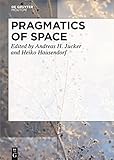Pragmatics of Space / ed. by Heiko Hausendorf, Andreas H. Jucker.
Material type: TextSeries: Handbooks of Pragmatics [HOPS] ; 14Publisher: Berlin ; Boston : De Gruyter Mouton, [2022]Copyright date: ©2022Description: 1 online resource (XIII, 747 p.)Content type:
TextSeries: Handbooks of Pragmatics [HOPS] ; 14Publisher: Berlin ; Boston : De Gruyter Mouton, [2022]Copyright date: ©2022Description: 1 online resource (XIII, 747 p.)Content type: - 9783110693553
- 9783110693812
- 9783110693713
- 400
- online - DeGruyter
- Issued also in print.
| Item type | Current library | Call number | URL | Status | Notes | Barcode | |
|---|---|---|---|---|---|---|---|
 eBook
eBook
|
Biblioteca "Angelicum" Pont. Univ. S.Tommaso d'Aquino Nuvola online | online - DeGruyter (Browse shelf(Opens below)) | Online access | Not for loan (Accesso limitato) | Accesso per gli utenti autorizzati / Access for authorized users | (dgr)9783110693713 |
Frontmatter -- Preface to the handbook series -- Preface -- Table of Contents -- 1. Doing space: The pragmatics of language and space -- I. Describing space through language -- 2. Deictic reference in space -- 3. The conceptualization of space in signed languages: Placing the signer in narratives -- 4. Spatiality in written texts -- 5. Interactional onomastics: Place names as malleable resources -- 6. Describing motion events -- 7. Discourses of place: The formation of space and place through discourse -- 8. Imaginary spaces in storytelling -- 9. Developmental perspectives on doing talk about space -- II. Spatial organization of social interaction -- 10. Encounters in public places: The establishment of interactional space in face-to-face openings -- 11. Interactional spaces in stationary, mobile, video-mediated and virtual encounters -- 12. The pragmatics of gesture and space -- 13. Distance and closeness: The im/politeness of space in communication -- III. Communicative resources of constructed spaces -- 14. Architecture-for-interaction: Built, designed and furnished space for communicative purposes -- 15. Building, dwelling, and interacting: Steps in the evolution of public space from Paleolithic to present -- 16. The pragmatics of linguistic landscapes -- 17. The pragmatics of written texts in space -- 18. Co-presence and beyond: Spatial configurations of communication in virtual environments -- IV. Pragmatics across space and cultures -- 19. Pragmatic variation across geographical and social space -- 20. Pragmatic variation across national varieties of pluricentric languages -- 21. Mapping perceptions and knowledge of language: Societal multilingualism and its sociopragmatic grounding -- Bionotes -- Author index -- Subject index
restricted access online access with authorization star
http://purl.org/coar/access_right/c_16ec
This handbook provides a comprehensive overview of spatial configurations of language use and of language use in space. It consists of four parts. The first part covers the various practices of describing space through language, including spatial references in spoken interaction or in written texts, the description of motion events as well as the creation of imaginative spaces in storytelling. The second part surveys aspects of the spatial organization of face-to-face communication including not only spatial arrangements of small groups in interaction but also the spatial dimension of sign language and gestures. The third part is devoted to the communicative resources of constructed spaces and the ways in which these facilitate and shape communication. Part four, finally, is devoted to pragmatics across space and cultures, i.e. the ways in which language use differs across language varieties, languages and cultures.
Issued also in print.
Mode of access: Internet via World Wide Web.
In English.
Description based on online resource; title from PDF title page (publisher's Web site, viewed 25. Jun 2024)


